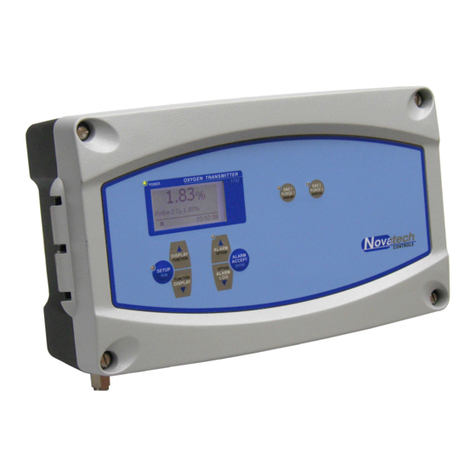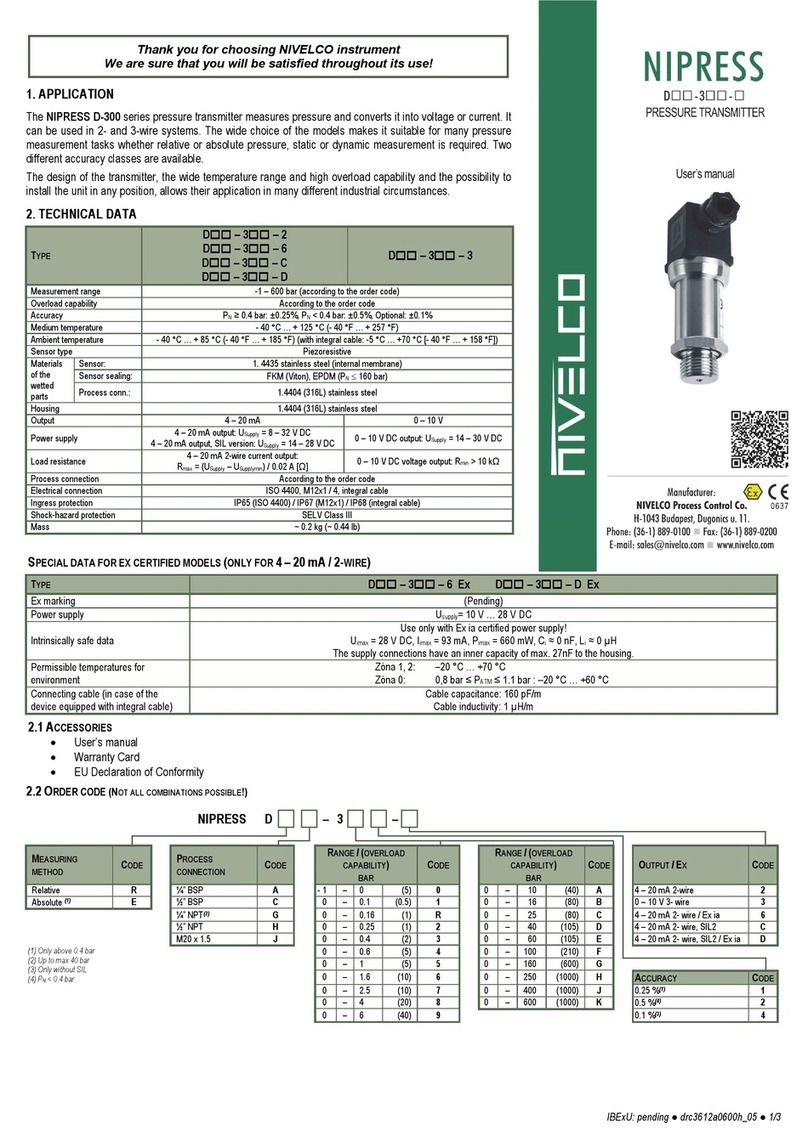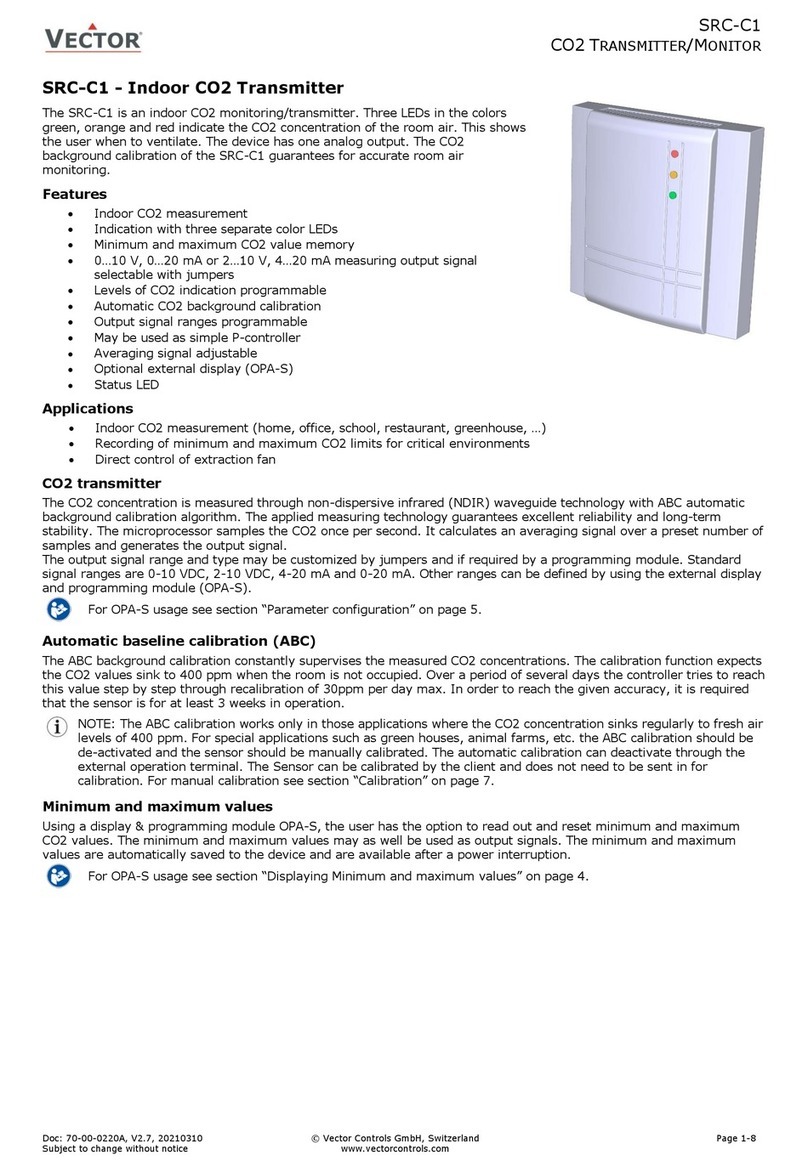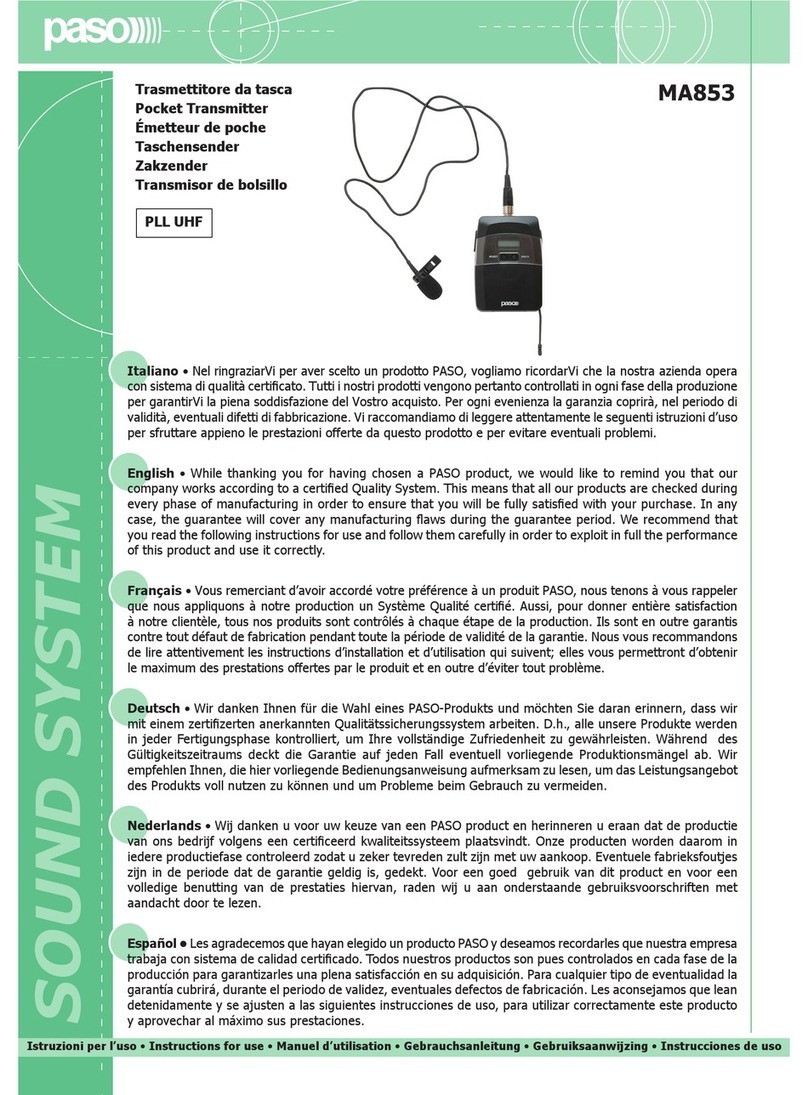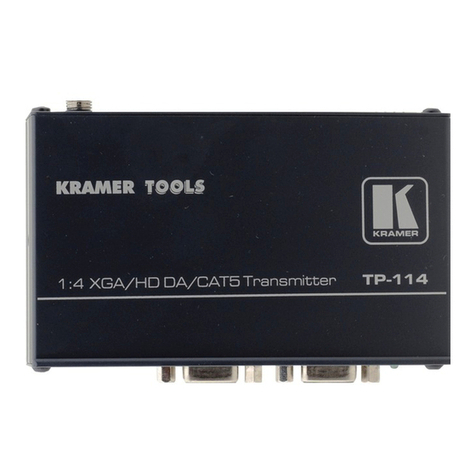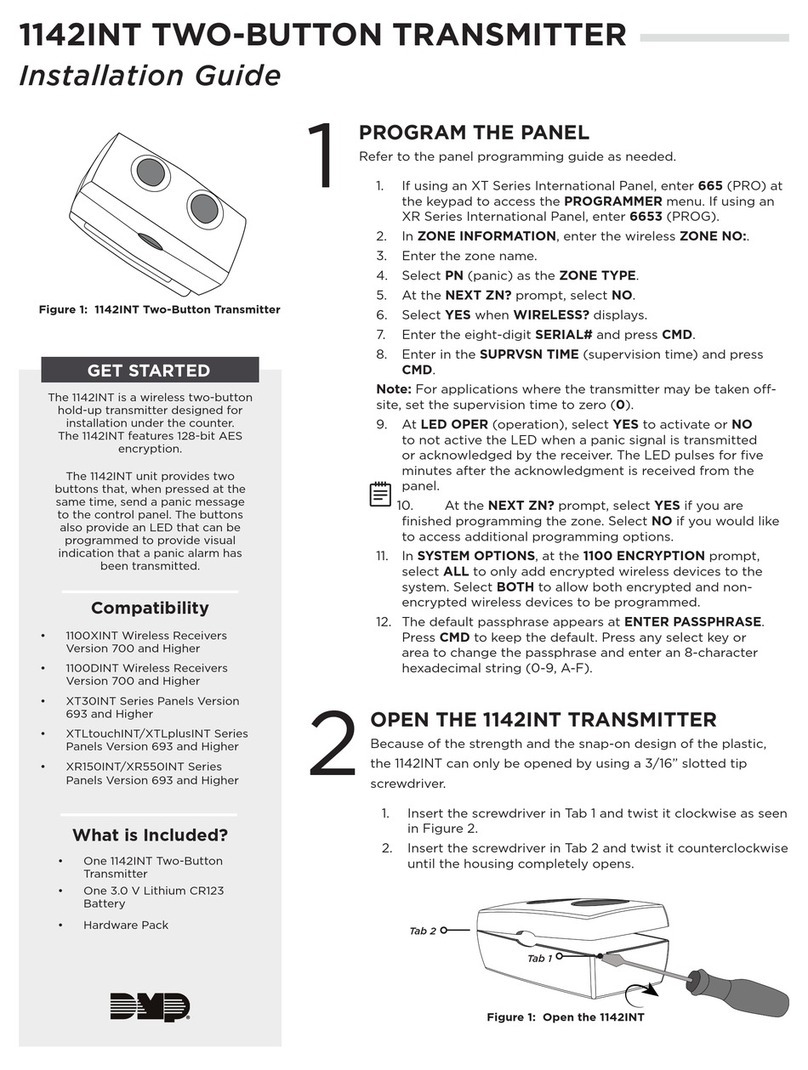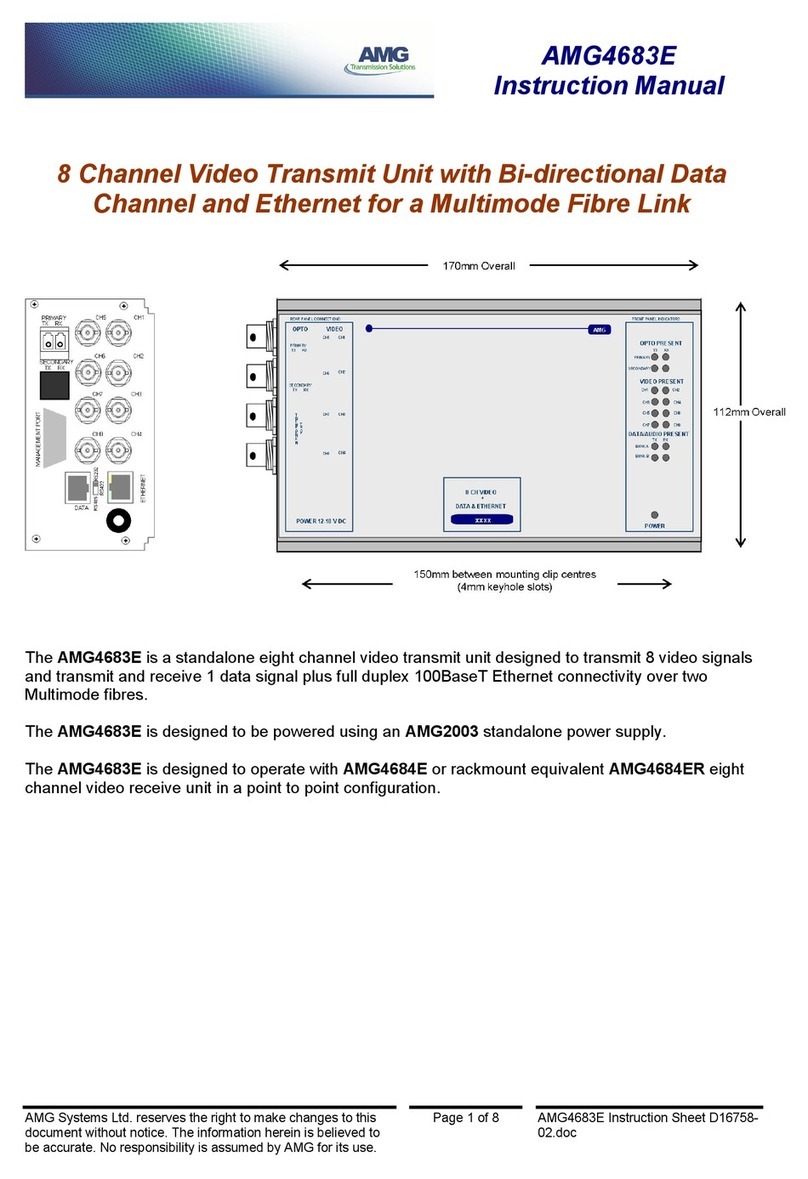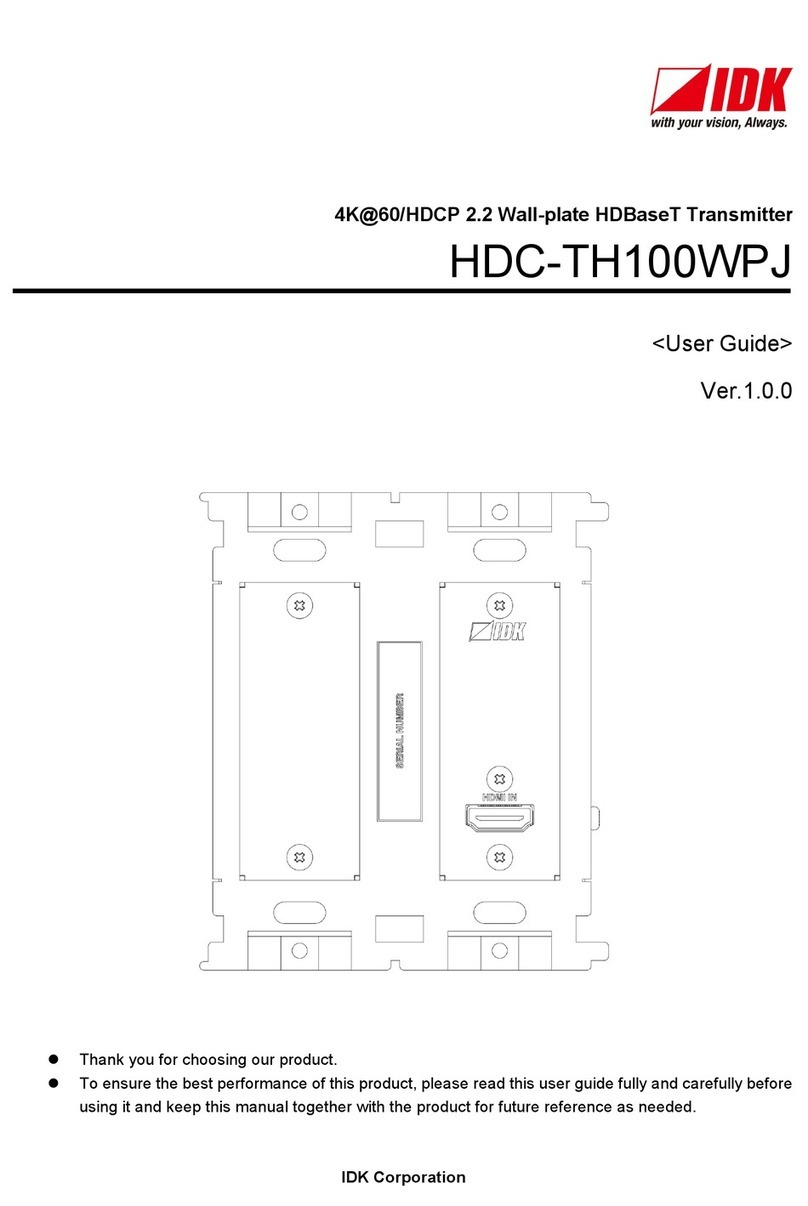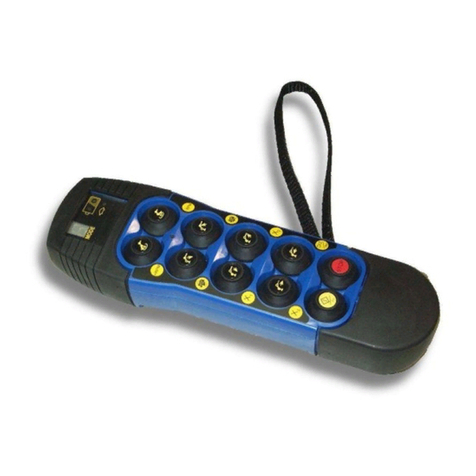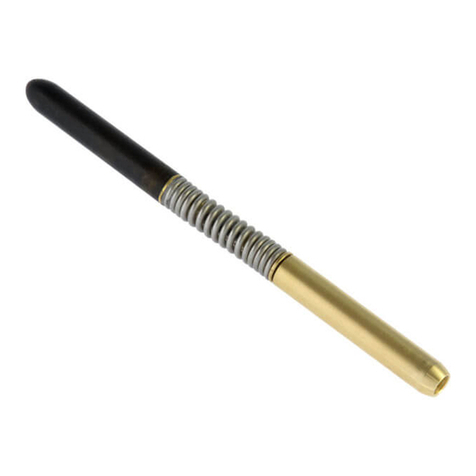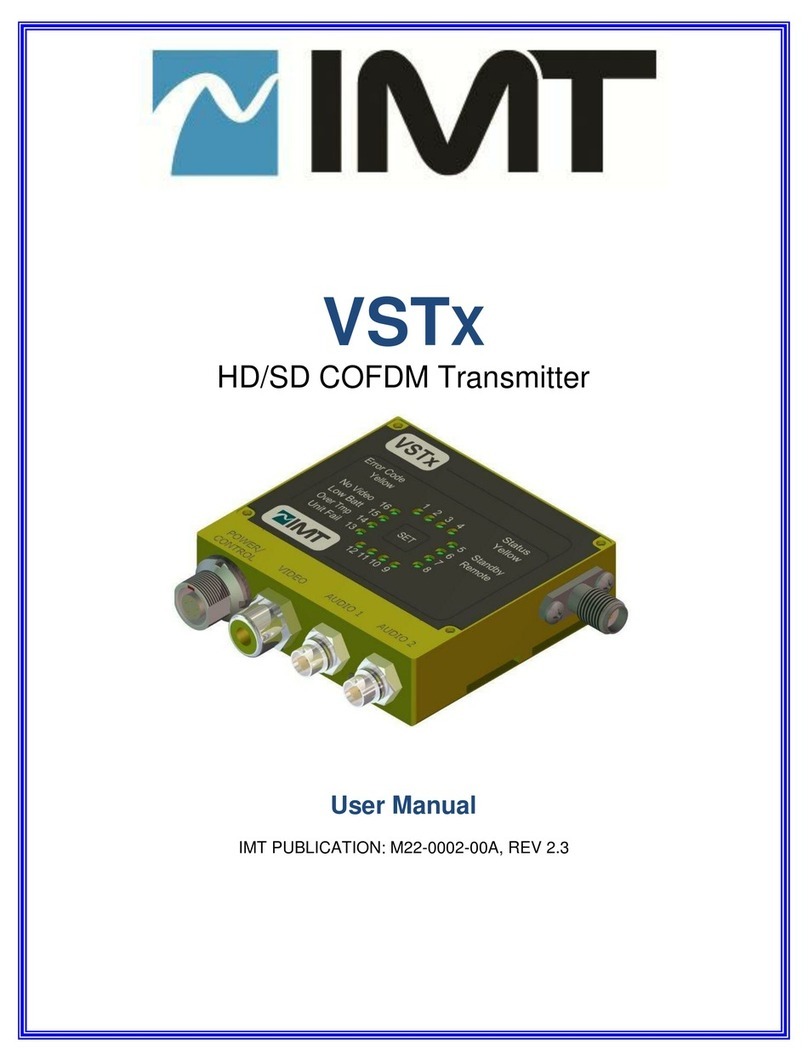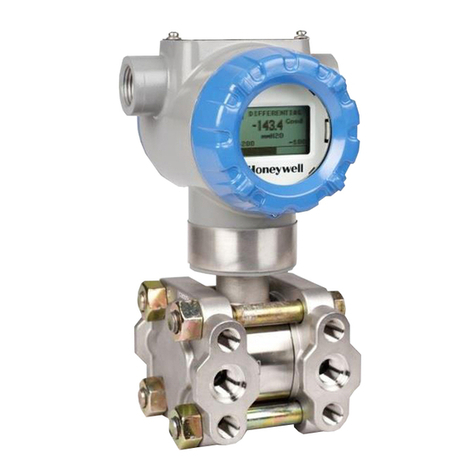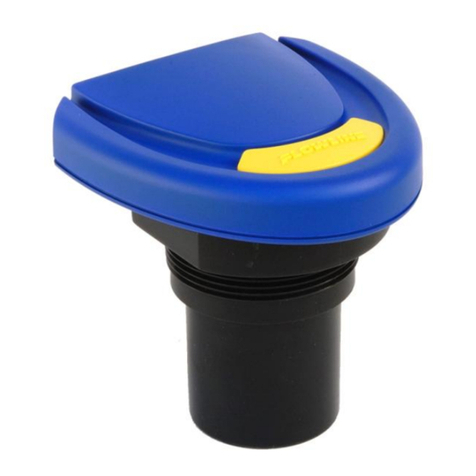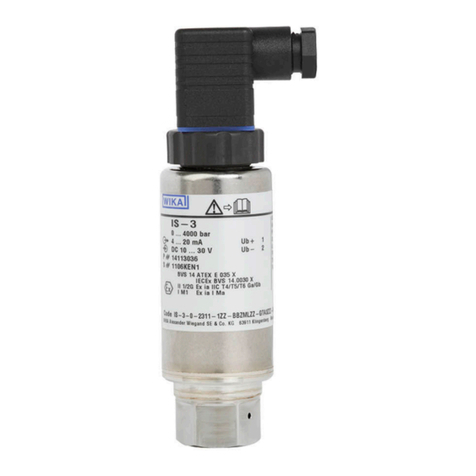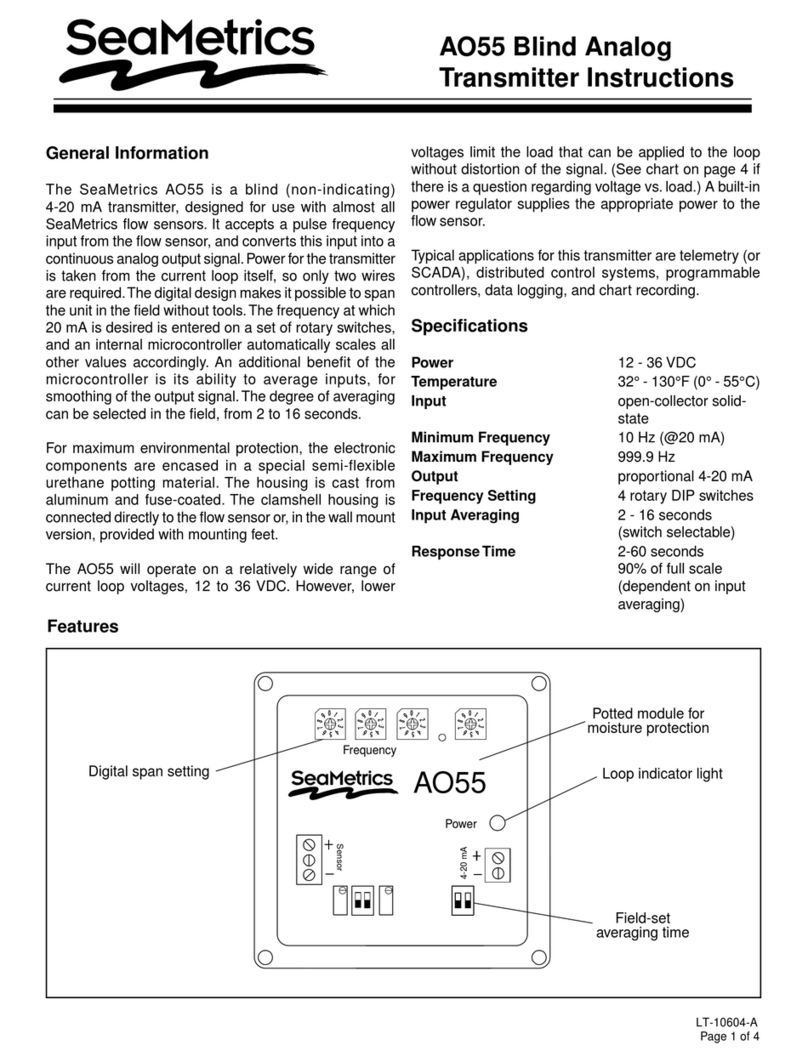Novatech CONTROLS 1738 User manual

Dew Point Transmitter
Model 1738
Technical Manual
April 2014


April 2014 Technical Manual
1738 Oxygen & Dew Point Transmitter 1
TABLE OF CONTENTS
TABLE OF CONTENTS.................................................................................................................................... 1
1. IMPORTANT NOTICES ................................................................................................................................ 7
2. INTRODUCTION........................................................................................................................................... 9
2.1 1738 TRANSMITTER.................................................................................................................................... 9
2.2 SERIES 1230 OXYGEN PROBES &SENSORS................................................................................................ 9
2.3 WARNING SYMBOLS ................................................................................................................................. 10
3. DEVICE SPECIFICATIONS........................................................................................................................ 11
3.1 HARDWARE SPECIFICATIONS..................................................................................................................... 11
3.1.1 Transmitter Specifications............................................................................................................... 11
3.1.2 Standard ‘U’ Lengths....................................................................................................................... 12
3.1.3 Series 1230 Probes Specifications ................................................................................................. 12
3.1.4 Oxygen Probe Model Selection Guide............................................................................................ 13
3.2 OPERATIONAL SPECIFICATIONS................................................................................................................. 14
4. INSTALLATION AND COMMISSIONING .................................................................................................. 15
4.1 MOUNTING THE TRANSMITTER................................................................................................................... 15
4.2 INSTALLING A 1231 OXYGEN PROBE.......................................................................................................... 15
4.3 INSTALLING A 1234 OXYGEN SENSOR ....................................................................................................... 17
4.4 INSTALLING THE AUXILIARY THERMOCOUPLE.............................................................................................. 17
4.5A SHIELD CONNECTIONS............................................................................................................................ 18
4.5B EARTH CONNECTION (PE)....................................................................................................................... 18
4.6 ELECTRICAL CONNECTIONS ...................................................................................................................... 19
4.7 HEATER INTERLOCK RELAYS..................................................................................................................... 21
4.8 CONNECTING AN OXYGEN PROBE CABLE................................................................................................... 22
4.9 CONNECTING A 1234 SENSOR CABLE........................................................................................................ 23
4.10 CONNECTING THE AUXILIARY THERMOCOUPLE (OPTIONAL)....................................................................... 23
4.11 CONNECTING THE OUTPUT CHANNELS .................................................................................................... 23
4.12 CONNECTING THE ALARMS...................................................................................................................... 23
4.13 CONNECTING THE AUTOMATIC PURGE AND CALIBRATION CHECK SYSTEM................................................. 24
4.14 CONNECTING REFERENCE AIR ................................................................................................................ 25
4.15 CONNECTING THE TRANSMITTER TO A MODBUS™ NETWORK.................................................................. 25
4.16 CONNECTING POWER ............................................................................................................................. 26
4.17 COMMISSIONING -RUN MODE................................................................................................................. 26
4.18 PROBE OR SENSOR CALIBRATION............................................................................................................ 26
4.19 FILTER PURGING .................................................................................................................................... 26
4.20 CALIBRATION GAS CHECK....................................................................................................................... 26
4.21 DUST IN THE FLUE GAS........................................................................................................................... 27
4.22 STRATIFICATION ..................................................................................................................................... 27
4.23 CONNECTING A FLUE PRESSURE TRANSDUCER ....................................................................................... 27
4.24 CONNECTING A HYDROGEN LEVEL TRANSDUCER..................................................................................... 27
5. DISPLAY AND KEYPAD ............................................................................................................................ 29
5.1 DISPLAY................................................................................................................................................... 29
5.2 TOP LINE DISPLAY.................................................................................................................................... 30
5.3 OXYGEN DISPLAY UNITS........................................................................................................................... 30
5.4 KEYPAD ................................................................................................................................................... 31
5.4.1 Keypad in RUN mode...................................................................................................................... 31
5.4.2 Keypad in SETUP / COMMISSIONING / CALIBRATION modes................................................... 32
5.5 INFORMATION SCREEN.............................................................................................................................. 33
6. SETUP MODE............................................................................................................................................. 35
6.1 FUNCTION SUMMARY TABLE...................................................................................................................... 35
6.2 CHANGING OPTIONS................................................................................................................................. 35
6.3 SETUP MODE FUNCTIONS ......................................................................................................................... 36

Technical Manual April 2014
21738 Oxygen & Dew Point Transmitter
6.3.1 Probe 1 Offset / Probe 2 Offset....................................................................................................... 36
6.3.2 Lower Line Items............................................................................................................................. 37
6.3.3 Oxygen Display Units...................................................................................................................... 37
6.3.4 Damping Factor............................................................................................................................... 37
6.3.5 Process Alarms............................................................................................................................... 37
7. COMMISSIONING MODE........................................................................................................................... 39
7.1 FUNCTION SUMMARY TABLE...................................................................................................................... 39
7.2 COMMISSIONING MODE FUNCTIONS........................................................................................................... 41
7.2.1 Internal Date / Time......................................................................................................................... 41
7.2.2 Service Date.................................................................................................................................... 41
7.2.3 Number of Probes........................................................................................................................... 41
7.2.4 Top Line .......................................................................................................................................... 41
7.2.5 Probe 1 & 2 Type ............................................................................................................................ 41
7.2.6 Probe 1 & 2 Thermocouple Type.................................................................................................... 41
7.2.7 Auxiliary Thermocouple Type.......................................................................................................... 41
7.2.8 Hydrogen Level............................................................................................................................... 41
7.2.9 Transmitter Output Channel 1 & 2 .................................................................................................. 42
7.2.10 Flue Pressure Units and Value ..................................................................................................... 42
7.2.11 Temperature Units......................................................................................................................... 42
7.2.12 Calibration Freezes Outputs ......................................................................................................... 42
7.2.13 Solenoid 1 & 2 Operation.............................................................................................................. 42
7.2.14 Solenoid 1 & 2 Automatic / Manual............................................................................................... 42
7.2.15 Solenoid 1 & 2 Start Time ............................................................................................................. 43
7.2.16 Solenoid 1 & 2 Period.................................................................................................................... 43
7.2.17 Solenoid 1 & 2 Duration ................................................................................................................ 43
7.2.18 Solenoid 1 & 2 Post Freeze .......................................................................................................... 43
7.2.19 Oxygen Content Calibration Gas 1 & 2......................................................................................... 43
7.2.20 Maximum Calibration Gas 1 & 2 Positive / Negative Error ........................................................... 43
7.2.21 Process Alarms ............................................................................................................................. 43
7.2.22 Alarm Relay 1, 2 and 3 Function................................................................................................... 43
7.2.23 Common Alarm Relay Function.................................................................................................... 44
7.2.24 Operation of the Alarm Relays when an Alarm is Accepted......................................................... 44
7.2.25 Reference Air Pump Options ........................................................................................................ 44
7.2.26 Communications Port Options ...................................................................................................... 44
7.2.27 Alarm Log Clearing........................................................................................................................ 45
8. CALIBRATION MODE................................................................................................................................ 47
8.1 FUNCTION SUMMARY TABLE...................................................................................................................... 47
8.2 CALIBRATION MODE FUNCTIONS ............................................................................................................... 48
8.2.1 Reference Voltages......................................................................................................................... 48
8.2.2 Output Channel 1 and 2 Calibration................................................................................................ 48
8.2.3 Ambient Temperature Calibration................................................................................................... 48
8.2.4 Low Oxygen Calibration.................................................................................................................. 48
8.2.5 Transmitter Output Scale ................................................................................................................ 48
8.2.6 Transmitter Output Limiting............................................................................................................. 48
8.2.7 Mains Voltage Detection ................................................................................................................. 48
8.2.8 Heater SSR Fault Correction .......................................................................................................... 48
8.2.9 SSR Fail Protection......................................................................................................................... 48
9. ALARMS ..................................................................................................................................................... 49
9.1 COMMON ALARMS .................................................................................................................................... 49
9.2 SELECTABLE PROCESS ALARMS................................................................................................................ 51
9.3 ALARM RELAY OPTIONS............................................................................................................................ 52
10. INSTRUMENT CALIBRATION ................................................................................................................. 53
10.1 CALIBRATION SUMMARY.......................................................................................................................... 53
10.1.1 Calibration of the Inputs ................................................................................................................ 53
10.1.2 Calibration of the Outputs ............................................................................................................. 53
10.1.3 Probe Calibration........................................................................................................................... 53
10.2 COLD START.......................................................................................................................................... 54

April 2014 Technical Manual
1738 Oxygen & Dew Point Transmitter 3
10.2.1 Forcing a Cold Start ...................................................................................................................... 54
10.2.2 Resetting the Calibration Factors.................................................................................................. 54
11. GAS CALIBRATION CHECK AND PURGE ............................................................................................ 55
11.1 PURGE................................................................................................................................................... 55
11.2 CALIBRATION GAS .................................................................................................................................. 55
12. SOFTWARE UPGRADES......................................................................................................................... 57
13. TROUBLESHOOTING.............................................................................................................................. 59
13.1 FIRST APPROACH ................................................................................................................................... 59
13.2 DETAILED FAULT ANALYSIS..................................................................................................................... 59
14. MAINTENANCE........................................................................................................................................ 61
14.1 TRANSMITTER MAINTENANCE.................................................................................................................. 61
14.2 CLEANING .............................................................................................................................................. 61
14.3REPLACEMENT PARTS............................................................................................................................. 61
15. INDEX........................................................................................................................................................ 62
APPENDIX 1, PROBE EMF TABLES ............................................................................................................ 63
APPENDIX 2, MODBUS™.............................................................................................................................. 65

Technical Manual April 2014
41738 Oxygen & Dew Point Transmitter
Copyright NOVATECH CONTROLS PTY LTD — 2014
This manual describes the transmitter firmware version 1.04, April 2014
Neither the whole nor any part of the information contained in, or the product described in, this manual may
be adapted or reproduced in any material form except with the prior written approval of Novatech Controls
Pty Ltd (Novatech).
The product described in this manual and products for use with it are subject to continuous developments
and improvement. All information of a technical nature and particulars of the product and its use (including
the information in this manual) are given by Novatech in good faith. However, it is acknowledged that there
may be errors or omissions in this manual. A list of details of any amendments or revisions to this manual
can be obtained upon request from Novatech Controls Technical Enquiries. Novatech Controls welcome
comments and suggestions relating to the product and this manual.
All correspondence should be addressed to: -
Technical Enquiries
Novatech Controls Pty Ltd
309 Reserve Road, Tel: +61 3 9585 2833
Cheltenham Fax: +61 3 9585 2844
Australia Web site: http://www.novatech.com.au/
Novatech Controls or their authorised dealers should carry out all maintenance and service on the product.
Novatech Controls can accept no liability whatsoever for any loss or damage caused by service or
maintenance by unauthorised personnel. This manual is intended only to assist the reader in the use of the
product, and therefore Novatech Controls shall not be liable for any loss or damage whatsoever arising from
the use of any information or particulars in, or any error or omission in, this manual, or any incorrect use of
the product.

April 2014 Technical Manual
1738 Oxygen & Dew Point Transmitter 5
Important Notice Regarding
1231 Probe Option - FIL-3
WARNING: The only identifiable standard for flame arresters for general use is British Standard BS EN
12874:2001. British Standard BS EN 12874:2001 refers to an operating environment up to 150 Degrees
Centigrade.
The FIL-3 device optionally fitted to 1231 Heated Zirconia Probes (the “Probes" or "Probe") operate in an
environment considerably greater than 150 Degrees Centigrade.
Therefore, we know of no Australian, British, European or USA standard applicable to flame arresters or their
testing above 150 degrees Centigrade. Consequently, the FIL-3 device cannot be certified as a safety
device.
The probe is only one of several potential sources of ignition. Extreme care is required when using the
probes during the start up processes of a combustion appliance.
The Novatech Burner Interlock Relay facility, which is a standard part of the Novatech transmitter, is
designed to be wired to the main safety shut-off fuel valves in a way that can shutdown the probe heater
when the fuel valves are closed.
The risk of ignition of flammable gas mixture at the hot end of the Probe can only be minimised by correct
use, maintenance and operation of the FIL-3 device. The user of the FIL-3 device is responsible for
verification and maintenance and correct use and operation of the FIL-3 device.
THE USER AGREES THAT IT USES THE PROBE AND THE FIL-3 DEVICE AT ITS SOLE RISK.
NOVATECH CONTROLS PTY LTD, TO THE FULL EXTENT PERMITTED BY LAW, GIVES NO
WARRANTIES OR ASSURANCES AND EXCLUDES ALL LIABILITY (INCLUDING LIABILITY FOR
NEGLIGENCE) IN RELATION TO THE PROBE AND THE FIL-3 DEVICE.
The user must ensure that it correctly follows all instructions in relation to the Probe and FIL-3 device,
correctly understands the specifications of the Probe and FIL-3 device and ensures that the Probe and FIL-3
device are regularly inspected and maintained.
FIL-3 equipped Probes should be inspected at least once a year for corrosion and more frequently if there is
any reason to suspect that corrosion may have occurred.

Technical Manual April 2014
61738 Oxygen & Dew Point Transmitter
This page has been intentionally left blank.

April 2014 Technical Manual
1738 Oxygen & Dew Point Transmitter 7
1. IMPORTANT NOTICES
This manual is intended as a supplement to the 1738 Operators Manual. It is intended to be used by
technical personal that are qualified to install, commission, service and calibrate electronic industrial control
equipment.
Please read the safety information below before connecting power to the transmitter.
CAUTION 1
The probe heater is supplied with mains voltage. This supply has electrical shock danger to maintenance
personnel. Always isolate the transmitter before working with the probe.
The EARTH wires (green/yellow) from a heated probe must ALWAYS be connected to earth.
CAUTION 2
Combustion or atmosphere control systems can be dangerous. Burners must be mechanically set up so that
in the case of equipment failure, the system cannot generate explosive atmospheres. This danger is
normally avoided with flue gas trim systems by adjustment so that in the case of failure the appliance will not
generate CO in excess of 400 ppm in the flue. The CO level in the flue should be measured with a separate
CO instrument, normally an infrared or fuel cell type.
CAUTION 3
The oxygen probe is heated to over 700°C (1300°F) and is a source of ignition. Since raw fuel leaks can
occur during burner shutdown, the transmitter has an interlocking relay that removes power from the probe
heater when the main fuel shut-off valve power is off. If this configuration does not suit or if it is possible for
raw fuel to come into contact with a hot oxygen probe then the Model 1738 transmitter with a heated probe
will not be safe in your application.
An unheated probe can be utilised in such applications, however the oxygen readings are valid only above
650°C (1200°F).
CAUTION 4
The reducing oxygen signal from the transmitter and the associated alarm relay can be used as an explosive
warning or trip. This measurement assumes complete combustion. If incomplete combustion is possible
then this signal will read less reducing and should not be used as an alarm or trip. A true excess
combustibles analyser, normally incorporating a catalyst or thermal conductivity bridge, would be more
appropriate where incomplete combustion is possible.
Also read the probe electrical shock caution in the probe heater interlock caution in chapter 4.7
CAUTION 5
FIL-3 filter. If the optional FIL-3 has been fitted to the 1231 probe in this installation, please read the
Important Notice regarding probe option FIL-3 on the previous page
CAUTION 6
The heater is supplied from the mains power directly, and the temperature is controlled at 720°C (1330°F).
The outside of the process end of the probe can get to temperatures that are dangerous to touch. Wear
insulating gloves when handling a probe that has been on.
CAUTION 7
Please note that if this equipment is not installed and used in the manner described in this manual then the
safety protection provided by the equipment may be impaired.

Technical Manual April 2014
81738 Oxygen & Dew Point Transmitter
This page has been intentionally left blank.

April 2014 Technical Manual
1738 Oxygen & Dew Point Transmitter 9
2. INTRODUCTION
2.1 1738 Transmitter
The Novatech 1738 Dew Point Transmitter provides in-situ measurement for one or two oxygen probes in
annealing and other furnaces with protective atmospheres of hydrogen / nitrogen. The transmitter provides
local indication of dew point and pre-reactive oxygen, as well as several other process related variables.
The transmitter is designed to be used in conjunction with a Novatech probe model 1231 or 1232. These
two probes use a zirconia sensor that must operate at >650°C. The 1231 probe has an integrated heater,
and the 1232 probe uses the process heat to heat the sensor. There is a unique cable connection between
the 1738 transmitter and the 1231/1232/1234 probe.
The model 1738 Dew Point Transmitter is based on the well known model 1638 transmitter. It includes a
number of hardware and software improvements such as a graphic display, larger characters, faster
microprocessor, simplified set up menu, alarm logging, faster probe heater control and a higher degree of
accuracy in calculating process variables.
The 1738 Dew Point Transmitter has a variety of user-selectable functions. They are simple to use because
each selection is menu driven. For options you are not sure about, read the manual on that particular item in
chapter 6, Setup Mode.
Features include:-
Inputs
Two zirconia oxygen probes, heated or unheated
Oxygen range from 10-30 to 100%
Furnace, kiln or flue thermocouple, field selectable as type K, J, R or S
Main flame established safety interlock (for heated probes only)
Purge pressure or flow switch
Outputs
Two linearised 4-20mA or 0-20mA DC isolated outputs, max. load 1000Ω
The output function and the range are field selectable
Common alarm relay
Three other alarm relays with selectable functions
Digital Interface
RS-232 or two wire RS-485 MODBUSfor connection to a computer/DCS/PCL for diagnostics of the
transmitter, probe or combustion process.
Display
Multi font graphical display
Large font characters for the oxygen on the top line
Selectable lower line items for the secondary display functions. ie Probe temperature, Oxygen second probe
Alarm display mode that shows the time of the alarm, the acceptance time and the time that the alarm was
cleared of up to 4000 alarm events
2.2 Series 1230 Oxygen Probes & Sensors
Novatech series 1230 oxygen probes and sensors employ state-of-the-art zirconia sensors and advanced
materials, which provide the following benefits:
Improved control due to fast response time to typically less than four seconds
Cost-efficient design provides improved reliability
Longer-life probes with greater resistance to corrosion from sulphur and zinc contaminants in flue gas
Low cost allows maintenance by replacement
Reduced probe breakage due to greater resistance to thermal shock and mechanical damage during
installation and start-up

Technical Manual April 2014
10 1738 Oxygen & Dew Point Transmitter
Series 1230 probe or sensors are simple to install and maintain. All models provide direct measurement of
oxygen level. On-line automatic calibration check is available if required. Probes or sensors may be used
with Novatech oxygen transmitters and some model transmitters from other manufacturers.
All Novatech oxygen probe or sensors are designed and manufactured to exacting standards of performance
and reliability. Series 1230 probe or sensors are the result of extensive research and development by
Novatech, industry and government agencies. Novatech Controls provides application and after sales
support for oxygen probes, sensors and transmitters, worldwide.
Model 1231 Heated Oxygen Probe
Model 1232 Unheated Oxygen Probe
2.3 Warning Symbols
Danger, high voltage. Risk of electrical shock.
Caution hot surface.
Caution, risk of danger. See additional information in the manual.

April 2014 Technical Manual
1738 Oxygen & Dew Point Transmitter 11
3. DEVICE SPECIFICATIONS
3.1 Hardware Specifications
3.1.1 Transmitter Specifications
Number of Oxygen Probes:
2 maximum
Oxygen Range:
1 x 10-30 to 100%
Dew Point Range:
-60°C to 40°C
Pre-Reactive Oxygen Range:
0 to 10%
Oxygen Accuracy:
±1% of actual measured oxygen value with a repeatability of ±0.5% of
the measured value
Thermocouple Types:
Type K, J, R and S
Temperature Accuracy:
±2°C
Analog Outputs:
2-wire 0-20mA or 4-20mA programmable
Active outputs (Do NOT loop power these outputs)
Analog Output Load:
1000 ohm max
Alarm Relays:
4
Alarm Relay Contacts:
2A/240VAC, 2A/30VDC
(WARNING: Do not use both mains voltage and low voltage connections to adjacent alarm contacts)
Mains Voltage Supply:
100 to 240VAC, -6 +10%, 50/60 Hz
Overvoltage:
Category II (IEC60364-4-443)
Power:
5W for controller plus probe power
530W max., 25% duty cycle each probe on 240VAC
110W max., 100% duty cycle each probe on 110VAC
2.5A max
Fuses:
3A, fast blow, 250v, 20x5mm (heater fuses, 2 of)
1A, slow blow, 250v, microfuse (PCB mtg fuse, 1 of)
Environmental Rating:
Operating Temperature -25°C to 55°C
Relative Humidity 5% to 95% (non-condensing)
Altitude:
2000m maximum
Degree of Protection:
IP65
IP54 with internal reference air pump
Case Size:
315mm (12.4”) wide, 190mm (7.5”) high, 110mm (4.3”) deep
Weight:
3 Kg (6.6 lbs.)
WARNING: All signal level connections onto the transmitter must be treated as safety extra-low
voltage (SELV) as defined in the standard IEC61140. Double insulation must be used when
connecting these terminals to systems that might carry high voltage.

Technical Manual April 2014
12 1738 Oxygen & Dew Point Transmitter
3.1.2 Standard ‘U’ Lengths
1231 1232
250 mm (10”) 500 mm (20”)
350 mm (14”) 750 mm (30”)
500 mm (20”) 1000 mm (40”)
750 mm (30”)
1000 mm (40”)
1500 mm (60”)
2000 mm (80”)
Ordering Information
Probe insertion length (from process end of mounting thread to probe sensing tip.
3.1.3 Series 1230 Probes Specifications
MODEL
1231
1232
Application
Combustion flue gases below 900°C
(1650°F)
Refer to note 1
Combustion flue gases above 700°C
(1290°F) with no contaminants.
eg. natural gas, light oils
Temperature Range
0 to 900°C. Refer to note 2
(32 to 1650°F)
700 to 1400°C
(1470 to 2550°F)
Length
250 to 2000 mm
(10” to 80”)
500 to 1000 mm
(20” to 40”)
Process Connection
1 ½" BSP or NPT
¾" BSP or NPT
Electrical Connection
Weatherproof plug-in connector or optional screw terminals.
The plug connector can be supplied with the cable.
Cable
Order a specific length with the transmitter
Heater
Yes
No
Thermocouple
K, integral
R, integral
Response Time
Typically < 4 secs.
Typically < 1 sec
Head Temperature
-25 to 100°C (-15 to 210°F) with weatherproof connector
-25 to 150°C (-15 to 300°F) with screw terminals
Reference Gas
Ambient air, 50 to 150 cc/min (3 to 9 scim). Pump can be supplied with
transmitter.
Ref Air Connection
1/4" NPT
Integral air line in probe cable. Barbed
fitting to 3/16" ID PVC tube.
Optional Filter
Removable sintered titanium alloy particulate filter,
30 micron standard, optional 15 micron available. Refer to note 2
Calibration Check Gas
Connection
1/8" NPT female
1/8" NPT female
Weight
2 kg (4.4 lb) plus 165 g (5.8 oz) / 100
mm (4”) length
1 kg (2.2 lb) plus 100 g (3.5 oz) / 100
mm (4”) length
Notes:
1. Care must be taken to avoid contact with explosive or inflammable gases with 1231 heated probes
and 1234 oxygen sensors when hot. Novatech transmitters have built in safety protection.
2. Process gas temperature must be below 800°C if the filters are fitted.
Please contact factory for corrosives other than sulphur or zinc. We can provide test materials to try in your
atmosphere.

April 2014 Technical Manual
1738 Oxygen & Dew Point Transmitter 13
3.1.4 Oxygen Probe Model Selection Guide
Heated probes-temperature range 0-900°C (1650°F).
Mounting Thread:
1. 1
1
2
" BSP Fixed
2. 1
1
2
" NPT Fixed
Internal Thermocouple:
1. Type K
max 900°C (1650°F)
Outer Sheath
1. Stainless Steel Grade 316
max 850°C (1560°F)
2. Inconel (*1)
'U' Length
2. 250mm (10")
3. 500mm (20")
4. 750mm (30")
5. 1000mm (40")
6. 1500mm (60")
7. 2000mm (80")
1231 - X - X - X - X
*Note: (1) Inconel probe has all Inconel® wetted parts except for the ceramic sensor and Viton® O-Rings.
Unheated probes for clean gases-temperature range 700-1400°C (1290-2550°F).
Mounting Thread:
1.
3
4
" BSP Fixed
2.
3
4
" NPT Fixed
Internal Thermocouple:
1. Nil (*2)
4. Type R
max 1400°C (2550°F)
Outer Sheath (*1)
1. Stainless Steel Grade 253MA
max 1100°C (2010°F)
3. High Purity Alumina
max 1300°C (2370°F) Horizontal
max 1400°C (2550°F) Vertical
'U' Length
3. 500mm (20")
4. 750mm (30")
5. 1000mm (40")
8. 1500mm (60")
7. Special length 140mm minimum
1232 - X - X - X - X
*Note: (2) A standard oxygen probe for carburising furnaces, has a 253 MA sheath.
1234 SENSOR SPECIFICATIONS
Range of measurement:1 ppm to 100% oxygen
Output: EMF = 2.154.10-2.T.loge(0.209/oxygen level of the sample)
Accuracy: ±1%
Thermocouple: Type K
Heater: 110 VAC 50 / 60Hz, 100 watts
Heater proportional band: 80°C (175°F)
Speed of Response: Less than 100 milliseconds
Sample flow rate: 1 to 5 litres / minute (120 to 600 scfm)
Differential Pressure: 80 to 800 mm (3 to 30”) WG gives a flow of 1 to 5 litres / min (120 to 600 scfm)
Process Connections: 1/4” NPT female, inlet and outlet
Dimensions: 300 mm (11.81”) high by 125 mm (4.92”) wide by 88 mm (3.46”) deep
Weight: 2.1 kg (4.6 lb)

Technical Manual April 2014
14 1738 Oxygen & Dew Point Transmitter
3.2 Operational Specifications
Range of outputs:
Function Minimum Maximum
Dew Point Probe 1 / 2
-60 to 20°C -40 to 40°C
Dew Point Average
Oxygen Probe 1 /2 0 to 99% 1 to 100%
Oxygen Average
Reducing Oxygen Probe 1 / 2
0 to 1x10-30% 0 to 100%
Reducing Oxygen Average
Pre-Reactive Oxygen Probe 1 / 2
0 to 9% 1 to 10%
Pre-Reactive Oxygen Average
Probe 1 / 2 EMF
0 to 1200mV
100 to 1300mV
Auxiliary TC Temperature 0 to 1300°C 100 to 1400°C
No output
Disables the output
Local display, lower line secondary display items:
Function
Range
Dew Point Probe 1 -40 to 60°C
Dew Point Probe 2
Dew Point Average
Probe 1 TC Temperature
up to 1760°C (3200°F)
Probe 2 TC Temperature
Probe 1 EMF
0 to 1300mV
Probe 2 EMF
Probe 1 Impedance 0 to 300kΩ
Probe 2 Impedance
Oxygen Probe 1
0 to 100%Oxygen Probe 2
Average Oxygen
Pre-Reactive Oxygen Probe 1
0 to 10%
Pre-Reactive Oxygen Probe 2
Pre-Reactive Oxygen Average
Auxiliary TC Temperature
up to 1760°C (3200°F)
Ambient Temperature
-20 to 70°C (-5 to 125°F)
Ambient Relative Humidity
5 to 95%
Flue Pressure
±3 Atm
Burner Runtime
Hours
Service Date
4-20mA Output 1
0 to 24mA
4-20mA Output 2

April 2014 Technical Manual
1738 Oxygen & Dew Point Transmitter 15
4. INSTALLATION AND COMMISSIONING
4.1 Mounting the Transmitter
Surface mount the transmitter case on to a flat surface or bracket, using the four mounting brackets
provided. The transmitter should never be mounted so that it is directly expose to the sun or rain. Always
leave at least 10cm of clearance around the four sides of the case.
Make sure the temperature of the case is below 55°C, and that the radiated heat from furnaces and boilers is
kept to a minimum. There should be adequate ventilation to maintain ambient temperature.
Install the cables through cable glands. There are 4 holes cut in the base of the transmitter case; 2x 17mm
& 2x 21mm. Use a sharp knife to cut away the covering film for only the glands that are needed.
NOTE: ALWAYS LEAVE THE UNUSED GLAND HOLES SEALED.
Ensure that the electrical connection complies with the local electrical requirements. (see chapter 4.6,
Electrical Connections)
Case Mounting Dimensions
4.2 Installing a 1231 Oxygen Probe
Weld a BSP or NPT socket to the flue in a suitable position for flue gas sensing. For the correct size of
socket refer to probe data in chapter 3.1.3. The closer to the source of combustion the smaller will be
sensing lag time, allowing better control.
The probe has a typical response time of less than four seconds, so most of the delay time is normally the
transit time of the gas from the point of combustion to the point of sensing.
Probes can be mounted at any angle. However, if the probe is to be mounted on a vertical duct wall, it is
better to angle the probe (approx. 15°) down to avoid process condensation inside the cold end of the probe.
If there are any particulates in the flue gas, a filter can be omitted by pointing the probe vertically downwards.
Otherwise the transmitter can be configured to automatically purge the filters, or they can be replaced
periodically.
314mm
188mm
350mm
147mm
275mm
221mm
110mm

Technical Manual April 2014
16 1738 Oxygen & Dew Point Transmitter
Oxygen Probe Mounting
CAUTION
It is important that there is no air in leakage upstream of the oxygen sensing point otherwise there will be a
high oxygen reading.
If the probe is to be installed on a bend in the flue, it is best located on the outer circumference of the bend to
avoid dead pockets of flue gas flow. While the standard 1231 probe with a ‘U’ length of 250 mm (10”) will
suit most low temperature flue applications, it is occasionally necessary to have a longer probe with the
sensing tip in the centre of the flue gas stream.
Although it is rare, occasionally a probe may sense oxygen vastly differently from the average reading in the
flue gas. If it occurs, then the probe should be moved, or a longer probe installed. This phenomenon is
normally caused by stratification of the flue gas.
Preferred mounting
angle if there are
particulates in the flue
gas and no filter is used
Probe may be mounted
horizontally but a small
angle downwards will
reduce condensation
Furnace,
Flue…

April 2014 Technical Manual
1738 Oxygen & Dew Point Transmitter 17
4.3 Installing a 1234 Oxygen Sensor
Mounting - Screw the 1234 sensor to a wall or similar surface with the piping connections at the top.
SAMP LE I N
EXHAUST
1234 OXYGEN SENSOR
NOVATECH
CONTROLS
CABLE GLAND
LABEL
EXHAUST 1/ 4" NPT
INLET 1/ 4" TUBE
10"
2.7"
250.00
25.00
1"
1.2"
30.00
56.00
0.8"
20.00
173.00
6.8"
1234 Sensor Mounting Dimensions
Sample Piping - Connect the gas sample piping to the “sample in” port. If the process, boiler, kiln or furnace
has a positive pressure, no suction will be required. If the sample is under a negative pressure, connect a
pump to the “inlet” port.The flow rate should be within the range of 1 to 5 litres/minute (120 to 600 scfm).
4.4 Installing the Auxiliary Thermocouple
Weld a 1/2 inch BSP mounting socket to the flue within about 300 mm (12”), and upstream of the oxygen
probe. The thermocouple should be of similar length to the oxygen probe to prevent flue temperature
distribution errors.
The thermocouple should be connected to terminals 7 & 8. These terminals will not be available for an
auxiliary thermocouple if a second probe has been installed.
Optional vent to
atmospherre
Optional return
to flue
Upward sloping
sample line 3/8”
stainless steel
Flue
Gas
Flowmeter
Sampling
Probe
1234
Sensor
Vent or return
to process
Dry
Process
Gas
1/4" Stainless Steel Tube
1234
Sensor

Technical Manual April 2014
18 1738 Oxygen & Dew Point Transmitter
4.5a Shield Connections
All external wiring to the 1738 transmitter should be shielded. Do not connect shields at the field end.
Simply clip off and insulate. There are two M4 earth screw terminals available in the 1738 transmitter. An
extra terminal strip may be required to connect all shields together. This should be supplied by the installer.
4.5b Earth connection (PE)
The PE (protective earth) input connection must be made to the earth stud on the right hand side of cabinet.
The PE input connection must be the first connection onto the earth stud and it must be secured by a
separate nut and spring washer. All other earth connections (bonding connections) can be made on either of
the two earth studs in the base of the cabinet.
The transmitter MUST be securely earthed.
Assembly of the PE and bonding connections on the earth stud
Incoming
PE wire
Other bonding
earth wires
Right hand
earth stud
Other manuals for 1738
1
Table of contents
Other Novatech CONTROLS Transmitter manuals
